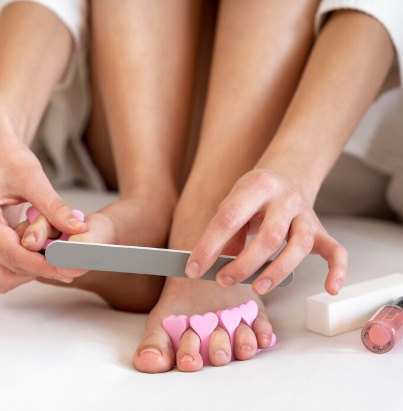Ingrown nail
An ingrown toenail is a common defect that occurs in both men and women at any age. Most often it occurs when wearing uncomfortable shoes, insufficient foot hygiene, or fungal infection of the nail. According to statistics, about 10% of the world's population faces this problem. Lack of timely treatment leads to serious complications, including gangrene and sepsis.

Best
specialists
specialists

Expert
equipment
equipment

Advanced diagnostic
treatment
treatment

Causes
- Improper nail care. A round or too short manicure can stimulate ingrown nails
- Narrow shoes. Shoes and boots that pinch your toes and nails can cause tissue damage. Blows, abrasions or regular rubbing of the feet often provoke ingrowth
- Sometimes onychocryptosis is inherited. In this case, its development is due to the structural features of the nail bed
Treatment methods
How to treat an ingrown toenail? The choice of method depends on the stage of the disease. In more severe cases, surgical treatment is performed. In this case, part or all of the nail is removed under local anesthesia.

Conservative treatment. For mild ingrown nails, local antiseptics, baths, lotions and orthopedic products (plasters, nylon threads, silicone gaskets) are used.

Minimally invasive methods. It is expected to use laser, radio waves, and cryodestruction.
General information about treating ingrown toenails
Our doctors
Make an appointment at a convenient time on the nearest date
Price
Primary appointment (examination, consultation) with a dermatovenerologist (podiatrist)
from 4 000 ₽
Repeated appointment (examination, consultation) with a dermatovenerologist (podiatrist)
from 3 500 ₽
Reviews 1

Appointment to the doctor
Fill out the form, our managers will contact you within 15 minutes
Our clinics
Didn't find the service you were looking for?
Call us!
+7 (495) 104-48-14
Write to whatsapp
Ask question











What is an ingrown toenail
An ingrown nail, or onychocryptosis, is a pathological condition in which the edge of the nail plate penetrates the soft tissue around the nail, causing swelling, redness and pain. It mainly occurs on the big toe. Particularly susceptible to the development of onychocryptosis people with flat feet and hallux valgus.
At the first sign of a problem, you should contact a surgeon or podiatrist. Professional treatment for ingrown toenails helps relieve pain and prevent unpleasant consequences.